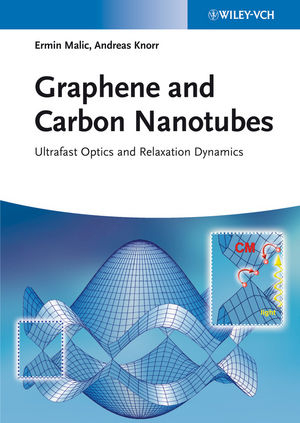Graphene and Carbon Nanotubes
Wiley-VCH (Verlag)
978-3-527-41161-0 (ISBN)
- Titel ist leider vergriffen;
keine Neuauflage - Artikel merken
The book introduces the reader into the ultrafast nanoworld of graphene and carbon nanotubes, including their microscopic tracks and unique optical finger prints.
A better understanding of the ultrafast relaxation dynamics of excited carriers is crucial for designing and engineering novel carbon-based optoelectronic devices. This book introduces the reader to the ultrafast nanoworld of graphene and carbon nanotubes including their unique properties and future perspectives.The authors review the recent progress in this field by combining theoretical and experimental achievements on microscopic processes in carbon nanostructures. The opening part provides the theoretical framework for the characterization of nanomaterials. Recent experimental breakthroughs, as techniques on pump-probe spectroscopy accessing the ultrafast carrier relaxation, are reviewed within a guest contribution.The next section is devoted to the electronic properties of graphene and CNT. Here, relaxation dynamics are discussed thoroughly.The third part deals with optical properties. The auhtors discuss absorption spectra in both graphene and CNT, considering smiconducting, metallic, and funcitonalized CNT.The authors offer a clear theoretical foundation which is based on equations derived within an in-depth appendix on the background of the theoretical description of carbon nanostructures: observables in optical experiments, second quantization, equations of motion, as well as mean-field and correlation effects .By combining both theory and experiment as well as main results and detailed theoretical derivations, the book turns into an inevitable source for a wider audience from graduate students to researchers in physics, materials science, and electrical engineering who work on optoelectronic devices, renewable energies, or in the semiconductor industry.
Ermin Malic graduated in Physics from Technical University (TU) Berlin. During his PhD thesis, he was a visiting researcher at the MIT and the University of Modena, Italy. From 2003 to 2008, he was a fellow of the Studienstiftung des Deutschen Volkes and the Friedrich-Ebert Stiftung. He received the DAAD and the Chorofas award for outstanding scientific research. After a post-doctoral stay at CIN2 in Barcelona, he is now leading the Einstein Junior Research Group on Microscopic Study of Carbon-based Hybrid Nanostructures at TU Berlin. Professor Andreas Knorr works in the field of nonlinear optics and quantum electronics of nanostructured solids. His research is focused on the interaction of light and matter, self-consistent solutions of Maxwell- and material equations and many body effects in open quantum systems. Since 2000 Andreas Knorr has a professorship at the Technical University of Berlin. His scientific career, which started at the Friedrich-Schiller-University Jena led him to the Universities of New Mexico, Arizona (College of Optical Sciences), Marburg, Göttingen and to Sandia National Labs Albuquerque and NTT Tokio.
1. Introduction - The Carbon Age
2. Theoretical Framework
3. Experimental techniques for the Study of Ultrafast Nonequilibrium Carrier Dynamics in Graphene
Part One: Electronic Properties - Carrier Relaxation Dynamics
4. Relaxation dynamics in graphene
5. Carrier Dynamics in Carbon Nanotubes
Part Two: Optical Properties - Absorption Spectra
6. Absorption Spectra of Carbon Nanotubes
7. Absorption Spectrum of Graphene
A Introduction to the Appendices
B Observables in Optical Experiments
C Second Quantization
D Equations of Motion
E Mean-Field and Correlation Effects
| Erscheint lt. Verlag | 30.4.2013 |
|---|---|
| Sprache | englisch |
| Maße | 170 x 240 mm |
| Gewicht | 795 g |
| Themenwelt | Naturwissenschaften ► Physik / Astronomie ► Atom- / Kern- / Molekularphysik |
| Naturwissenschaften ► Physik / Astronomie ► Festkörperphysik | |
| Schlagworte | Electrical & Electronics Engineering • Electrical & Electronics Engineering • Electronic materials • Elektronische Materialien • Elektrotechnik u. Elektronik • Festkörperphysik • Graphen • Nanomaterial • Nanomaterialien • nanomaterials • Nanoröhre • Nanoröhren • Nanostrukturiertes Material • Nanotechnologie • nanotechnology • Physics • Physik • Solid state physics |
| ISBN-10 | 3-527-41161-5 / 3527411615 |
| ISBN-13 | 978-3-527-41161-0 / 9783527411610 |
| Zustand | Neuware |
| Haben Sie eine Frage zum Produkt? |
aus dem Bereich




